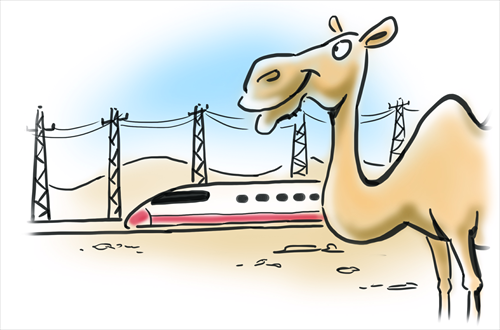‘One Belt, One Road’ follows worldwide pattern of regional integration

Illustration: Liu Rui/GT
One of the key recent policies launched by China is the "One Belt, One Road" initiative announced by President Xi Jinping. As this simultaneously combines both economic and diplomatic aspects, it provides an important part of the international context for discussion at the ongoing two sessions. But the strategic importance of the "One Belt, One Road" policy should not be seen as a short-term or specific tactical policy by China.
Globalization remains the overall trend in the world economy. But it is important to be clear that it is not an even or undifferentiated international process. In particular, geographical proximity continues to play a significant role in shaping economies.
Within the overall framework of rising world trade, it is striking that the development of international division of labor has now reached a point where the "classic" sized nation state, on a scale that dominated Europe in the 19th and most of the 20th centuries, and which exists in large parts of Asia, is too small by itself to constitute a sufficiently developed economic unit.
This trend itself creates globalization. But instead of a fully "equalized" global economy being created, in which geography does not play a significant role, there is instead an emerging division into "continental scale" economic units which are replacing "national" ones.
The US was the world's first continental scale economy. The USSR was the second, ultimately failed, continental scale economy, though it remains to be seen how much of the former USSR will be reintegrated in the Eurasian Economic Union.
China is, as with the US, in political terms a nation state but also history's third continental scale economy; India is the fourth continental economy, and if it succeeds in integrating itself fully, the EU will be the fifth continental economy.
It is also clear that to gain the advantages of international division of labor, international trade, and other factors, the most successful of these "continental economies" have a tendency to integrate themselves with surrounding regions even in cases where political union is not posed.
The US has therefore created very strong economic links with Mexico and Canada, formalized in the North American Free Trade Agreement (NAFTA). The EU has progressively expanded from its original six-member West European nucleus to form an integrated European economic zone including 28 member states and several closely associated ones.
The willingness of smaller economies to create links with these larger "continental" scale economic hubs in turn reflects the fact that these smaller economies by themselves cannot achieve the scale of production required for the most efficient operation in a modern economy.
The "win-win" outcome is therefore that the continental-scale economic hub benefits from expanding further its scale of participation in global division of labor, while the smaller economies benefit from their increased links with a larger economy.
Isolation from such trends leaves smaller countries unable to benefit from the developing global division of labor, with negative consequences for their own growth. China has the advantage of being a "continental" scale economy, but for success even this requires economic integration with geographically surrounding economies. In turn, these smaller surrounding economies benefit from their relation with China's continental scale economy. This creates a win-win outcome even when there is no intention in Asia to follow the EU route of political integration. Equally there is no move toward political integration of Canada or Mexico with the US.
Countries in Southeast Asia similarly face important choices between the continental scale economy of China, which forms the economic center of the Asian region, and non-Asian states particularly the US. Some, such as the Philippines, currently attempt to resolve this through subordination to the US. Others, such as contemporary Indonesia, attempt to balance various trends through a "non-political" stance. Some, such as Thailand, have experienced internal differences on the issue.
China is in the fortunate political position that it faces no such choice. China's fundamental strategy for "national renewal" continues to be building up its own "continental" economy. But this, in turn, requires building mutually beneficial relations with its surrounding neighbors. It is clear from these reasons that the "One Belt, One Road" is not a short-term initiative but of major strategic significance for both China and its neighbors.
The author is a senior fellow of the Chongyang Institute for Financial Studies, Renmin University of China, and the former director of Economic and Business Policy of London. opinion@globaltimes.com.cn